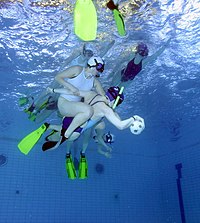Underwater rugby

Underwater rugby match in Norway.
|
|
| Highest governing body | CMAS |
|---|---|
| Nicknames | UWR |
| First played | 1961, Cologne, Germany |
| Characteristics | |
| Contact | yes |
| Team members | 12 (6 in play) |
| Mixed gender | Yes, except at elite levels |
| Type | Aquatic |
| Equipment | diving mask, snorkel, fins, water polo cap. |
| Venue | Swimming pool |
Underwater rugby (UWR) is an underwater team sport. During a match two teams try to score a negatively buoyant ball (filled with saltwater) into the opponents’ goal at the bottom of a swimming pool. It originated from within the physical fitness training regime existing in German diving clubs during the early 1960s and has little in common with rugby football except for the name. It was recognised by the Confédération Mondiale des Activités Subaquatiques (CMAS) in 1978 and was first played as a world championship in 1980.
It is played under water in a pool with a depth of 3.5m to 5m and goals (heavy metal buckets with a diameter of about 40 cm) at the bottom of the pool. Two teams (blue and white), each with six players (plus six substitutes), try to score a goal by sending the slightly negatively buoyant ball (filled with saltwater) into the opponents’ goal. It is a fast and exhausting game; therefore, the subs replace their players on the fly.
The ball may be passed in any direction but must not leave the water. It "flies" about 2m or 3m before water resistance stops it. This makes good tactics and good (three-dimensional) positioning essential. The players need all sorts of different abilities: Strength, speed, agility or good teamplay are all similarly important.
In 1961 a member of the German Underwater Club (DUC) in Cologne, Ludwig von Bersuda, came up with the idea of an underwater ball game. Air-filled balls are not suitable for underwater games, as they are buoyant and always return to the surface. The first underwater ball was invented when Bersuda filled the ball with saltwater. Since the density of the ball was now greater than that of normal water, it no longer floated to the surface, but slowly sank to the bottom. The sink rate could, within certain limits, be controlled by the concentration of the salt solution. As soccer balls are too large to be practical, waterpolo balls are used.
Ludwig von Bersuda spanned the middle of the pool with a net, as in volleyball, that stopped 1 m above the pool bottom. Two teams played against each other: the offensive team had to carry the ball to the opposing field and put it into a bucket. The idea for the game was ready, and the DUC Cologne used it to warm up before normal training. Other teams saw this and started to use saltwater-filled balls themselves.
...
Wikipedia
